Griffith University CCJ7103: Mental Disorder and Crime Analysis
VerifiedAdded on 2022/08/24
|9
|2461
|18
Essay
AI Summary
This essay delves into the complex relationship between mental disorders and criminal behavior, specifically focusing on psychopathy and antisocial personality disorder (ASPD). The author explores the core characteristics of both conditions, including the triarchic model of psychopathy (boldness, disinhibition, meanness) and the behavioral traits associated with ASPD, such as deceitfulness and lack of empathy. The essay examines whether these constructs are distinct or overlapping, concluding that they represent different entities. It highlights key differences, such as the presence or absence of a conscience and the potential for manipulation. Furthermore, the essay discusses the implications of these differences for treatment, suggesting that while sociopaths (ASPD) may benefit from therapies like CBT, psychopaths are often resistant to treatment due to their inherent lack of empathy and potential for manipulation, and therefore, require different approaches. The author supports their arguments with references to various research studies and concludes by emphasizing the long-term challenges in managing and treating individuals with these disorders within the criminal justice system.
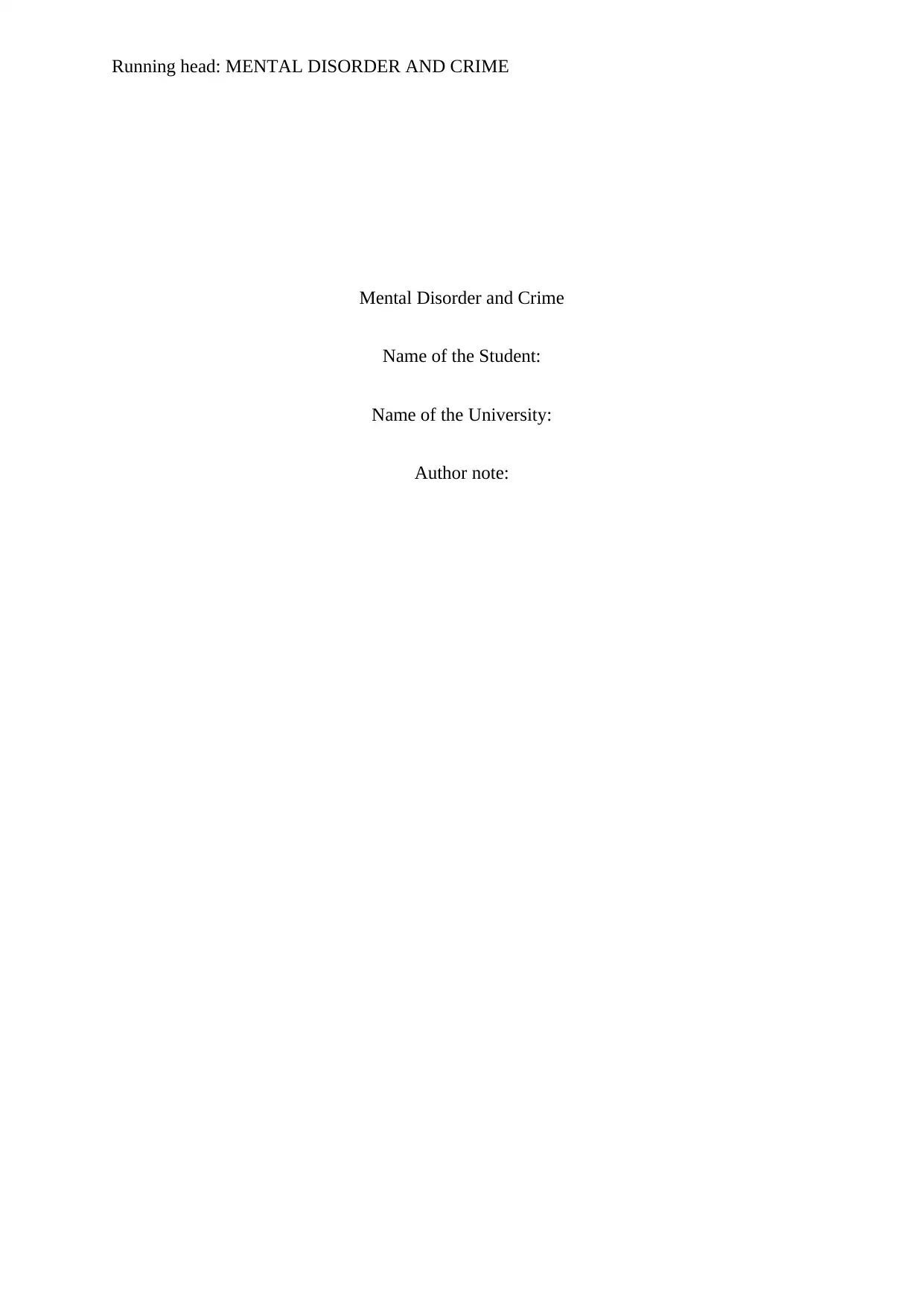
Running head: MENTAL DISORDER AND CRIME
Mental Disorder and Crime
Name of the Student:
Name of the University:
Author note:
Mental Disorder and Crime
Name of the Student:
Name of the University:
Author note:
Secure Best Marks with AI Grader
Need help grading? Try our AI Grader for instant feedback on your assignments.
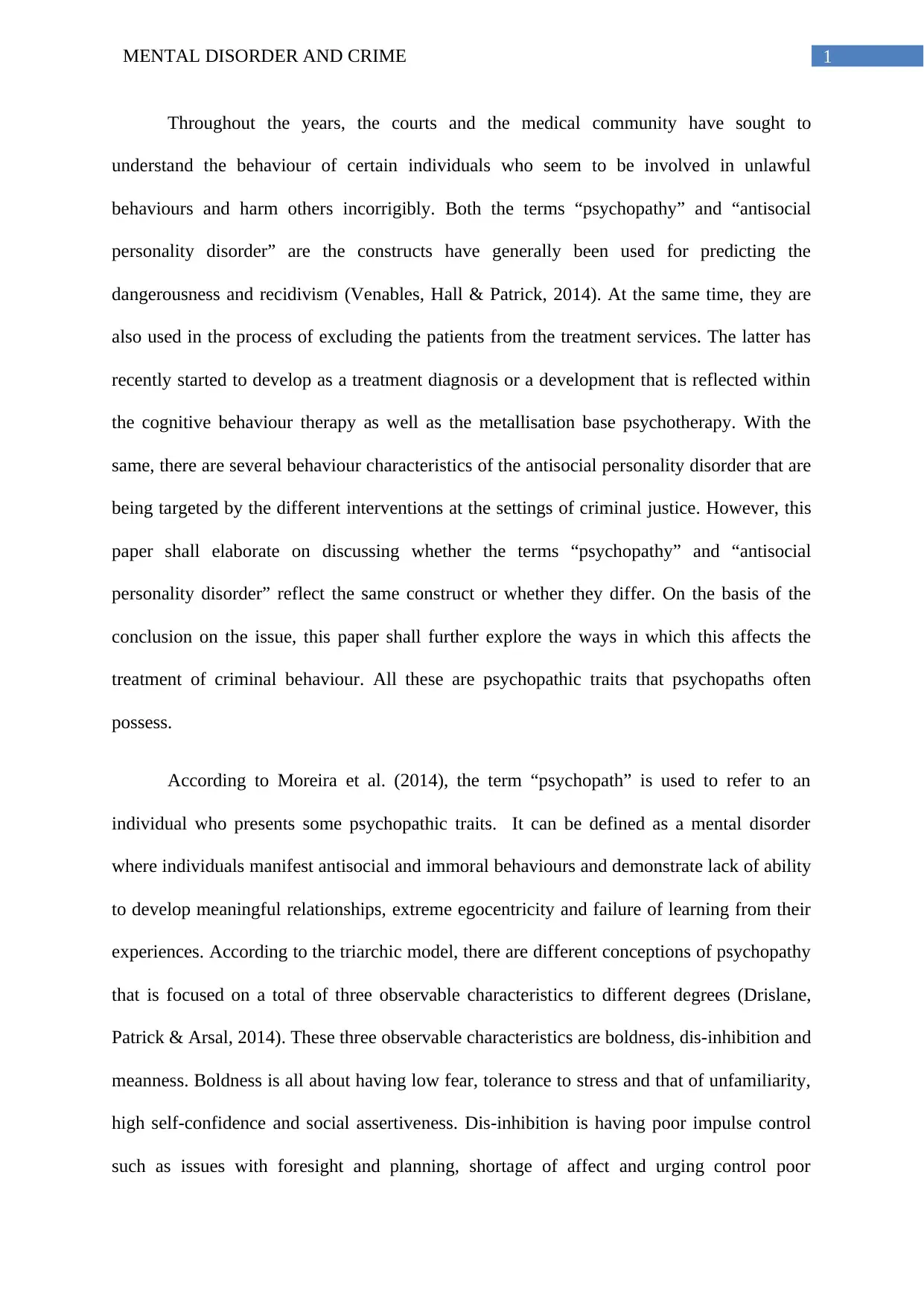
1MENTAL DISORDER AND CRIME
Throughout the years, the courts and the medical community have sought to
understand the behaviour of certain individuals who seem to be involved in unlawful
behaviours and harm others incorrigibly. Both the terms “psychopathy” and “antisocial
personality disorder” are the constructs have generally been used for predicting the
dangerousness and recidivism (Venables, Hall & Patrick, 2014). At the same time, they are
also used in the process of excluding the patients from the treatment services. The latter has
recently started to develop as a treatment diagnosis or a development that is reflected within
the cognitive behaviour therapy as well as the metallisation base psychotherapy. With the
same, there are several behaviour characteristics of the antisocial personality disorder that are
being targeted by the different interventions at the settings of criminal justice. However, this
paper shall elaborate on discussing whether the terms “psychopathy” and “antisocial
personality disorder” reflect the same construct or whether they differ. On the basis of the
conclusion on the issue, this paper shall further explore the ways in which this affects the
treatment of criminal behaviour. All these are psychopathic traits that psychopaths often
possess.
According to Moreira et al. (2014), the term “psychopath” is used to refer to an
individual who presents some psychopathic traits. It can be defined as a mental disorder
where individuals manifest antisocial and immoral behaviours and demonstrate lack of ability
to develop meaningful relationships, extreme egocentricity and failure of learning from their
experiences. According to the triarchic model, there are different conceptions of psychopathy
that is focused on a total of three observable characteristics to different degrees (Drislane,
Patrick & Arsal, 2014). These three observable characteristics are boldness, dis-inhibition and
meanness. Boldness is all about having low fear, tolerance to stress and that of unfamiliarity,
high self-confidence and social assertiveness. Dis-inhibition is having poor impulse control
such as issues with foresight and planning, shortage of affect and urging control poor
Throughout the years, the courts and the medical community have sought to
understand the behaviour of certain individuals who seem to be involved in unlawful
behaviours and harm others incorrigibly. Both the terms “psychopathy” and “antisocial
personality disorder” are the constructs have generally been used for predicting the
dangerousness and recidivism (Venables, Hall & Patrick, 2014). At the same time, they are
also used in the process of excluding the patients from the treatment services. The latter has
recently started to develop as a treatment diagnosis or a development that is reflected within
the cognitive behaviour therapy as well as the metallisation base psychotherapy. With the
same, there are several behaviour characteristics of the antisocial personality disorder that are
being targeted by the different interventions at the settings of criminal justice. However, this
paper shall elaborate on discussing whether the terms “psychopathy” and “antisocial
personality disorder” reflect the same construct or whether they differ. On the basis of the
conclusion on the issue, this paper shall further explore the ways in which this affects the
treatment of criminal behaviour. All these are psychopathic traits that psychopaths often
possess.
According to Moreira et al. (2014), the term “psychopath” is used to refer to an
individual who presents some psychopathic traits. It can be defined as a mental disorder
where individuals manifest antisocial and immoral behaviours and demonstrate lack of ability
to develop meaningful relationships, extreme egocentricity and failure of learning from their
experiences. According to the triarchic model, there are different conceptions of psychopathy
that is focused on a total of three observable characteristics to different degrees (Drislane,
Patrick & Arsal, 2014). These three observable characteristics are boldness, dis-inhibition and
meanness. Boldness is all about having low fear, tolerance to stress and that of unfamiliarity,
high self-confidence and social assertiveness. Dis-inhibition is having poor impulse control
such as issues with foresight and planning, shortage of affect and urging control poor
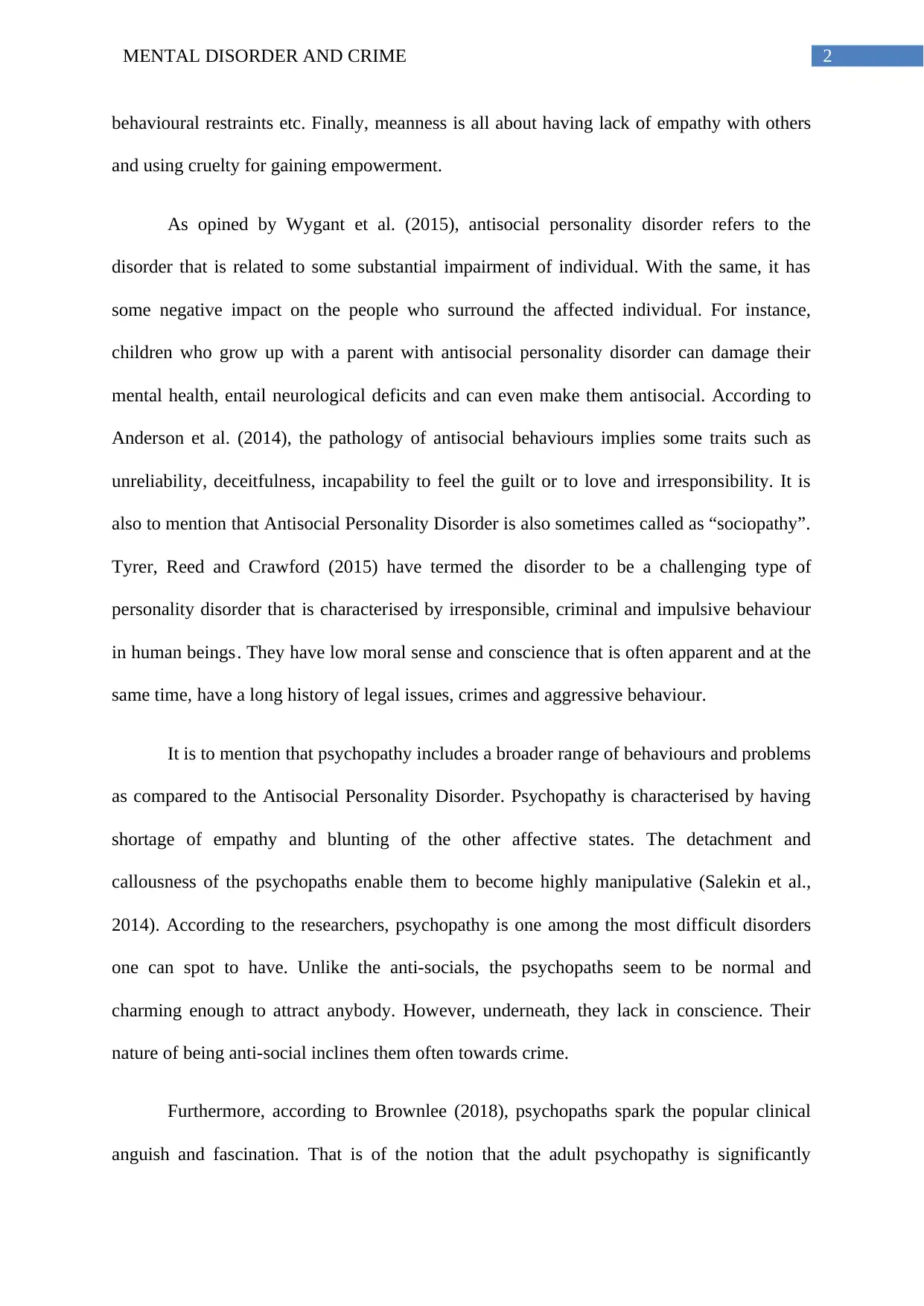
2MENTAL DISORDER AND CRIME
behavioural restraints etc. Finally, meanness is all about having lack of empathy with others
and using cruelty for gaining empowerment.
As opined by Wygant et al. (2015), antisocial personality disorder refers to the
disorder that is related to some substantial impairment of individual. With the same, it has
some negative impact on the people who surround the affected individual. For instance,
children who grow up with a parent with antisocial personality disorder can damage their
mental health, entail neurological deficits and can even make them antisocial. According to
Anderson et al. (2014), the pathology of antisocial behaviours implies some traits such as
unreliability, deceitfulness, incapability to feel the guilt or to love and irresponsibility. It is
also to mention that Antisocial Personality Disorder is also sometimes called as “sociopathy”.
Tyrer, Reed and Crawford (2015) have termed the “disorder to be a challenging type of
personality disorder that is characterised by irresponsible, criminal and impulsive behaviour
in human beings”. They have low moral sense and conscience that is often apparent and at the
same time, have a long history of legal issues, crimes and aggressive behaviour.
It is to mention that psychopathy includes a broader range of behaviours and problems
as compared to the Antisocial Personality Disorder. Psychopathy is characterised by having
shortage of empathy and blunting of the other affective states. The detachment and
callousness of the psychopaths enable them to become highly manipulative (Salekin et al.,
2014). According to the researchers, psychopathy is one among the most difficult disorders
one can spot to have. Unlike the anti-socials, the psychopaths seem to be normal and
charming enough to attract anybody. However, underneath, they lack in conscience. Their
nature of being anti-social inclines them often towards crime.
Furthermore, according to Brownlee (2018), psychopaths spark the popular clinical
anguish and fascination. That is of the notion that the adult psychopathy is significantly
behavioural restraints etc. Finally, meanness is all about having lack of empathy with others
and using cruelty for gaining empowerment.
As opined by Wygant et al. (2015), antisocial personality disorder refers to the
disorder that is related to some substantial impairment of individual. With the same, it has
some negative impact on the people who surround the affected individual. For instance,
children who grow up with a parent with antisocial personality disorder can damage their
mental health, entail neurological deficits and can even make them antisocial. According to
Anderson et al. (2014), the pathology of antisocial behaviours implies some traits such as
unreliability, deceitfulness, incapability to feel the guilt or to love and irresponsibility. It is
also to mention that Antisocial Personality Disorder is also sometimes called as “sociopathy”.
Tyrer, Reed and Crawford (2015) have termed the “disorder to be a challenging type of
personality disorder that is characterised by irresponsible, criminal and impulsive behaviour
in human beings”. They have low moral sense and conscience that is often apparent and at the
same time, have a long history of legal issues, crimes and aggressive behaviour.
It is to mention that psychopathy includes a broader range of behaviours and problems
as compared to the Antisocial Personality Disorder. Psychopathy is characterised by having
shortage of empathy and blunting of the other affective states. The detachment and
callousness of the psychopaths enable them to become highly manipulative (Salekin et al.,
2014). According to the researchers, psychopathy is one among the most difficult disorders
one can spot to have. Unlike the anti-socials, the psychopaths seem to be normal and
charming enough to attract anybody. However, underneath, they lack in conscience. Their
nature of being anti-social inclines them often towards crime.
Furthermore, according to Brownlee (2018), psychopaths spark the popular clinical
anguish and fascination. That is of the notion that the adult psychopathy is significantly
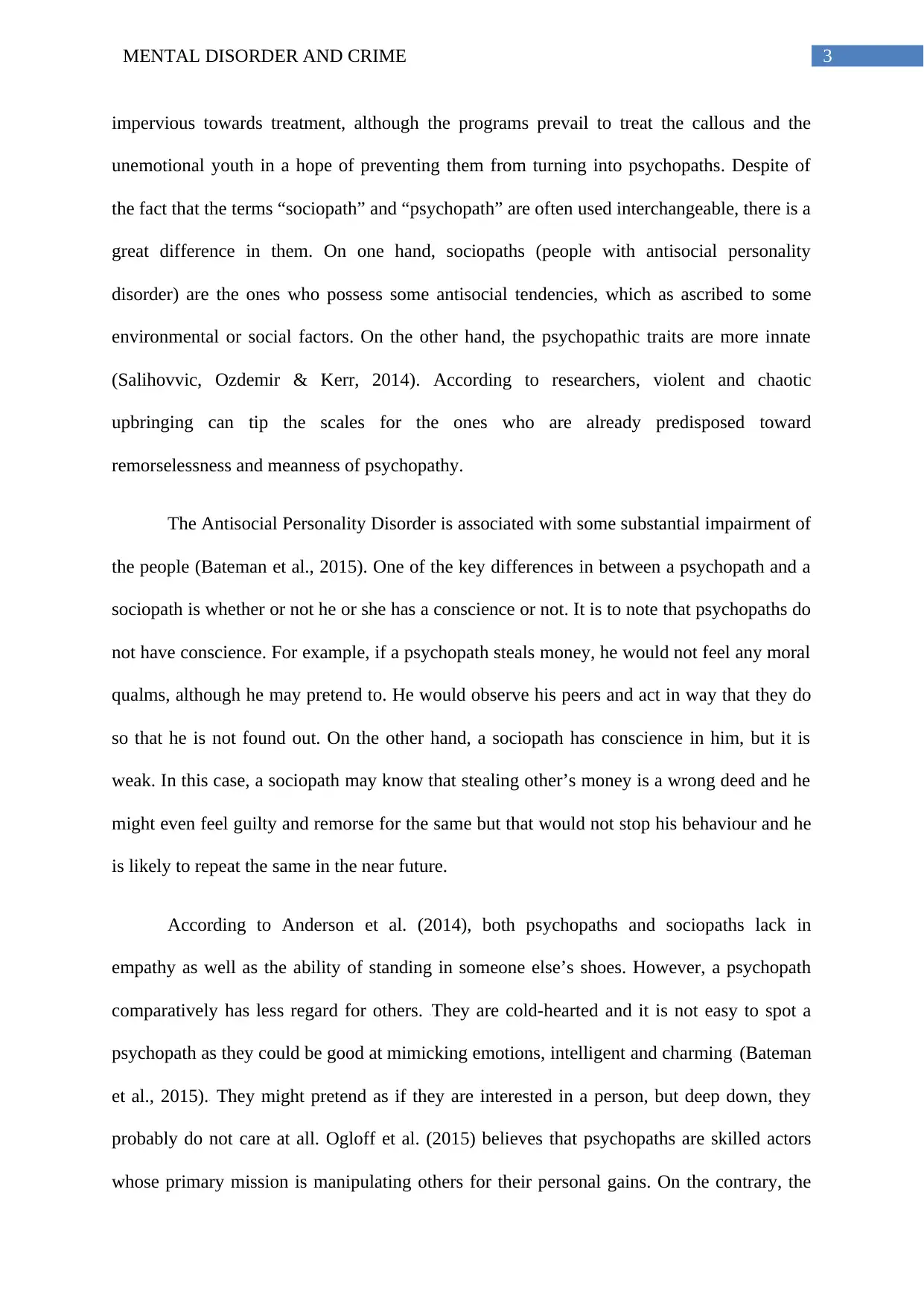
3MENTAL DISORDER AND CRIME
impervious towards treatment, although the programs prevail to treat the callous and the
unemotional youth in a hope of preventing them from turning into psychopaths. Despite of
the fact that the terms “sociopath” and “psychopath” are often used interchangeable, there is a
great difference in them. On one hand, sociopaths (people with antisocial personality
disorder) are the ones who possess some antisocial tendencies, which as ascribed to some
environmental or social factors. On the other hand, the psychopathic traits are more innate
(Salihovvic, Ozdemir & Kerr, 2014). According to researchers, violent and chaotic
upbringing can tip the scales for the ones who are already predisposed toward
remorselessness and meanness of psychopathy.
The Antisocial Personality Disorder is associated with some substantial impairment of
the people (Bateman et al., 2015). One of the key differences in between a psychopath and a
sociopath is whether or not he or she has a conscience or not. It is to note that psychopaths do
not have conscience. For example, if a psychopath steals money, he would not feel any moral
qualms, although he may pretend to. He would observe his peers and act in way that they do
so that he is not found out. On the other hand, a sociopath has conscience in him, but it is
weak. In this case, a sociopath may know that stealing other’s money is a wrong deed and he
might even feel guilty and remorse for the same but that would not stop his behaviour and he
is likely to repeat the same in the near future.
According to Anderson et al. (2014), both psychopaths and sociopaths lack in
empathy as well as the ability of standing in someone else’s shoes. However, a psychopath
comparatively has less regard for others. “They are cold-hearted and it is not easy to spot a
psychopath as they could be good at mimicking emotions, intelligent and charming” (Bateman
et al., 2015).” They might pretend as if they are interested in a person, but deep down, they
probably do not care at all. Ogloff et al. (2015) believes that psychopaths are skilled actors
whose primary mission is manipulating others for their personal gains. On the contrary, the
impervious towards treatment, although the programs prevail to treat the callous and the
unemotional youth in a hope of preventing them from turning into psychopaths. Despite of
the fact that the terms “sociopath” and “psychopath” are often used interchangeable, there is a
great difference in them. On one hand, sociopaths (people with antisocial personality
disorder) are the ones who possess some antisocial tendencies, which as ascribed to some
environmental or social factors. On the other hand, the psychopathic traits are more innate
(Salihovvic, Ozdemir & Kerr, 2014). According to researchers, violent and chaotic
upbringing can tip the scales for the ones who are already predisposed toward
remorselessness and meanness of psychopathy.
The Antisocial Personality Disorder is associated with some substantial impairment of
the people (Bateman et al., 2015). One of the key differences in between a psychopath and a
sociopath is whether or not he or she has a conscience or not. It is to note that psychopaths do
not have conscience. For example, if a psychopath steals money, he would not feel any moral
qualms, although he may pretend to. He would observe his peers and act in way that they do
so that he is not found out. On the other hand, a sociopath has conscience in him, but it is
weak. In this case, a sociopath may know that stealing other’s money is a wrong deed and he
might even feel guilty and remorse for the same but that would not stop his behaviour and he
is likely to repeat the same in the near future.
According to Anderson et al. (2014), both psychopaths and sociopaths lack in
empathy as well as the ability of standing in someone else’s shoes. However, a psychopath
comparatively has less regard for others. “They are cold-hearted and it is not easy to spot a
psychopath as they could be good at mimicking emotions, intelligent and charming” (Bateman
et al., 2015).” They might pretend as if they are interested in a person, but deep down, they
probably do not care at all. Ogloff et al. (2015) believes that psychopaths are skilled actors
whose primary mission is manipulating others for their personal gains. On the contrary, the
Secure Best Marks with AI Grader
Need help grading? Try our AI Grader for instant feedback on your assignments.
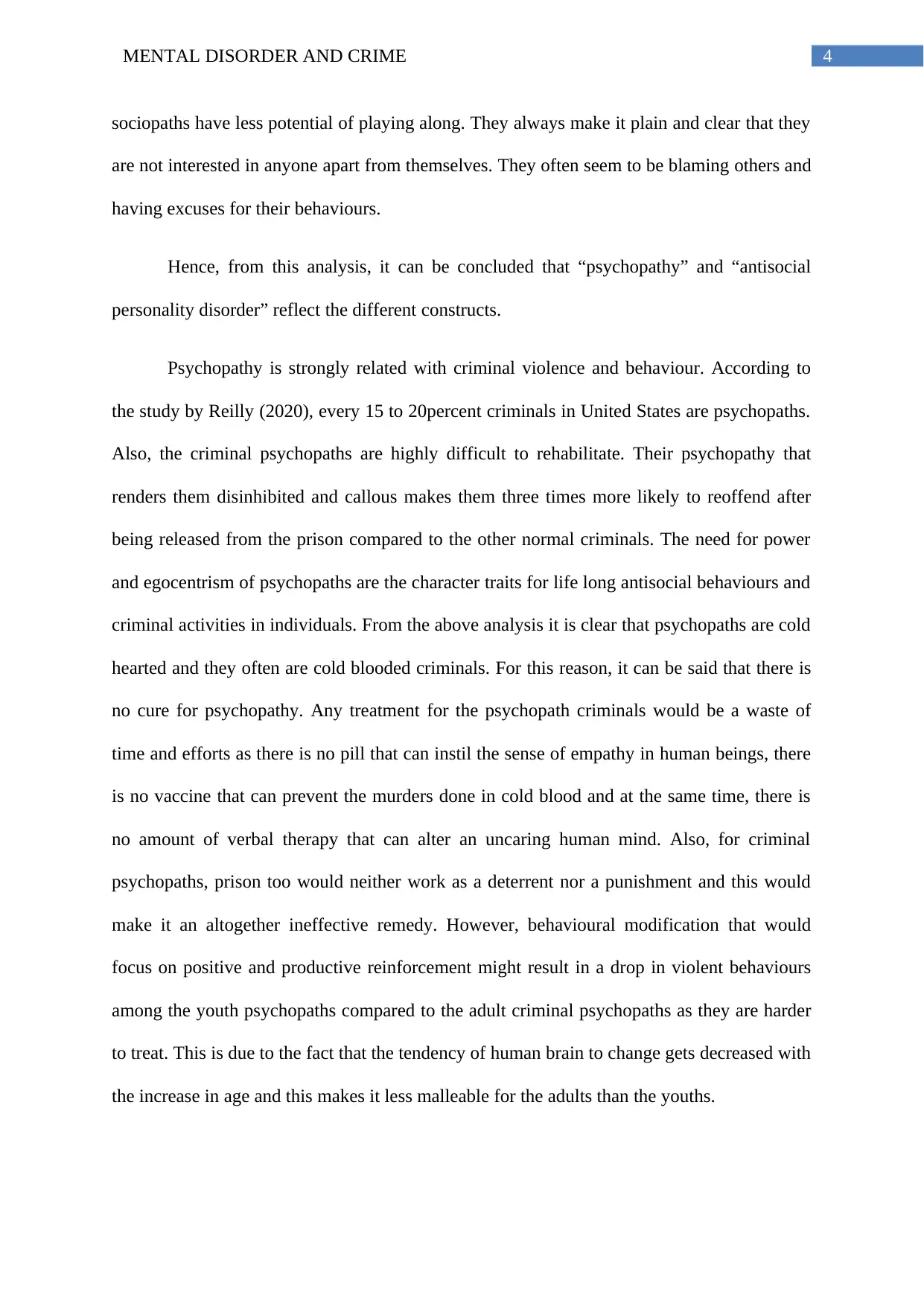
4MENTAL DISORDER AND CRIME
sociopaths have less potential of playing along. They always make it plain and clear that they
are not interested in anyone apart from themselves. They often seem to be blaming others and
having excuses for their behaviours.
Hence, from this analysis, it can be concluded that “psychopathy” and “antisocial
personality disorder” reflect the different constructs.
Psychopathy is strongly related with criminal violence and behaviour. According to
the study by Reilly (2020), every 15 to 20percent criminals in United States are psychopaths.
Also, the criminal psychopaths are highly difficult to rehabilitate. Their psychopathy that
renders them disinhibited and callous makes them three times more likely to reoffend after
being released from the prison compared to the other normal criminals. The need for power
and egocentrism of psychopaths are the character traits for life long antisocial behaviours and
criminal activities in individuals. From the above analysis it is clear that psychopaths are cold
hearted and they often are cold blooded criminals. For this reason, it can be said that there is
no cure for psychopathy. Any treatment for the psychopath criminals would be a waste of
time and efforts as there is no pill that can instil the sense of empathy in human beings, there
is no vaccine that can prevent the murders done in cold blood and at the same time, there is
no amount of verbal therapy that can alter an uncaring human mind. Also, for criminal
psychopaths, prison too would neither work as a deterrent nor a punishment and this would
make it an altogether ineffective remedy. However, behavioural modification that would
focus on positive and productive reinforcement might result in a drop in violent behaviours
among the youth psychopaths compared to the adult criminal psychopaths as they are harder
to treat. This is due to the fact that the tendency of human brain to change gets decreased with
the increase in age and this makes it less malleable for the adults than the youths.
sociopaths have less potential of playing along. They always make it plain and clear that they
are not interested in anyone apart from themselves. They often seem to be blaming others and
having excuses for their behaviours.
Hence, from this analysis, it can be concluded that “psychopathy” and “antisocial
personality disorder” reflect the different constructs.
Psychopathy is strongly related with criminal violence and behaviour. According to
the study by Reilly (2020), every 15 to 20percent criminals in United States are psychopaths.
Also, the criminal psychopaths are highly difficult to rehabilitate. Their psychopathy that
renders them disinhibited and callous makes them three times more likely to reoffend after
being released from the prison compared to the other normal criminals. The need for power
and egocentrism of psychopaths are the character traits for life long antisocial behaviours and
criminal activities in individuals. From the above analysis it is clear that psychopaths are cold
hearted and they often are cold blooded criminals. For this reason, it can be said that there is
no cure for psychopathy. Any treatment for the psychopath criminals would be a waste of
time and efforts as there is no pill that can instil the sense of empathy in human beings, there
is no vaccine that can prevent the murders done in cold blood and at the same time, there is
no amount of verbal therapy that can alter an uncaring human mind. Also, for criminal
psychopaths, prison too would neither work as a deterrent nor a punishment and this would
make it an altogether ineffective remedy. However, behavioural modification that would
focus on positive and productive reinforcement might result in a drop in violent behaviours
among the youth psychopaths compared to the adult criminal psychopaths as they are harder
to treat. This is due to the fact that the tendency of human brain to change gets decreased with
the increase in age and this makes it less malleable for the adults than the youths.
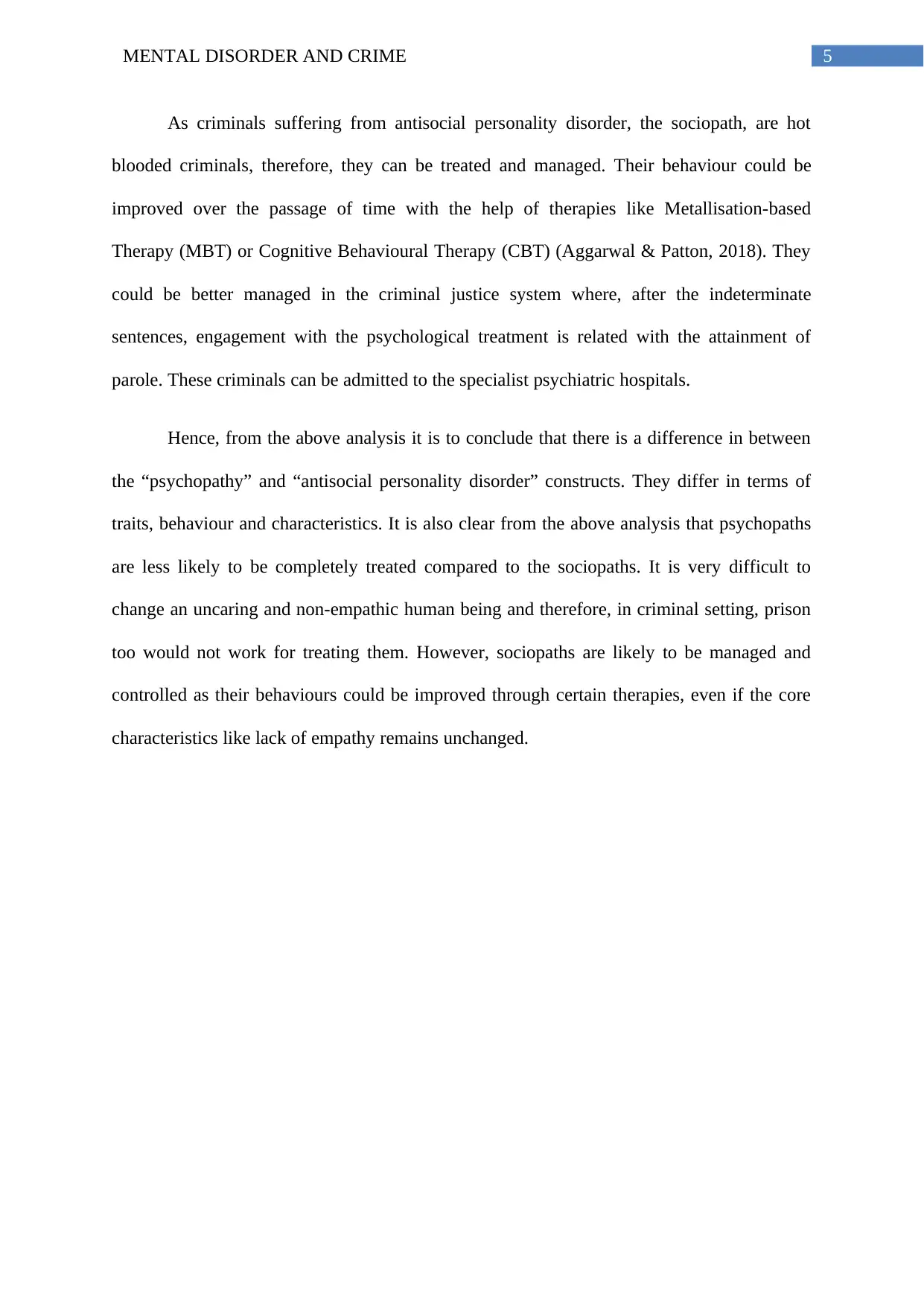
5MENTAL DISORDER AND CRIME
As criminals suffering from antisocial personality disorder, the sociopath, are hot
blooded criminals, therefore, they can be treated and managed. Their behaviour could be
improved over the passage of time with the help of therapies like Metallisation-based
Therapy (MBT) or Cognitive Behavioural Therapy (CBT) (Aggarwal & Patton, 2018). They
could be better managed in the criminal justice system where, after the indeterminate
sentences, engagement with the psychological treatment is related with the attainment of
parole. These criminals can be admitted to the specialist psychiatric hospitals.
Hence, from the above analysis it is to conclude that there is a difference in between
the “psychopathy” and “antisocial personality disorder” constructs. They differ in terms of
traits, behaviour and characteristics. It is also clear from the above analysis that psychopaths
are less likely to be completely treated compared to the sociopaths. It is very difficult to
change an uncaring and non-empathic human being and therefore, in criminal setting, prison
too would not work for treating them. However, sociopaths are likely to be managed and
controlled as their behaviours could be improved through certain therapies, even if the core
characteristics like lack of empathy remains unchanged.
As criminals suffering from antisocial personality disorder, the sociopath, are hot
blooded criminals, therefore, they can be treated and managed. Their behaviour could be
improved over the passage of time with the help of therapies like Metallisation-based
Therapy (MBT) or Cognitive Behavioural Therapy (CBT) (Aggarwal & Patton, 2018). They
could be better managed in the criminal justice system where, after the indeterminate
sentences, engagement with the psychological treatment is related with the attainment of
parole. These criminals can be admitted to the specialist psychiatric hospitals.
Hence, from the above analysis it is to conclude that there is a difference in between
the “psychopathy” and “antisocial personality disorder” constructs. They differ in terms of
traits, behaviour and characteristics. It is also clear from the above analysis that psychopaths
are less likely to be completely treated compared to the sociopaths. It is very difficult to
change an uncaring and non-empathic human being and therefore, in criminal setting, prison
too would not work for treating them. However, sociopaths are likely to be managed and
controlled as their behaviours could be improved through certain therapies, even if the core
characteristics like lack of empathy remains unchanged.
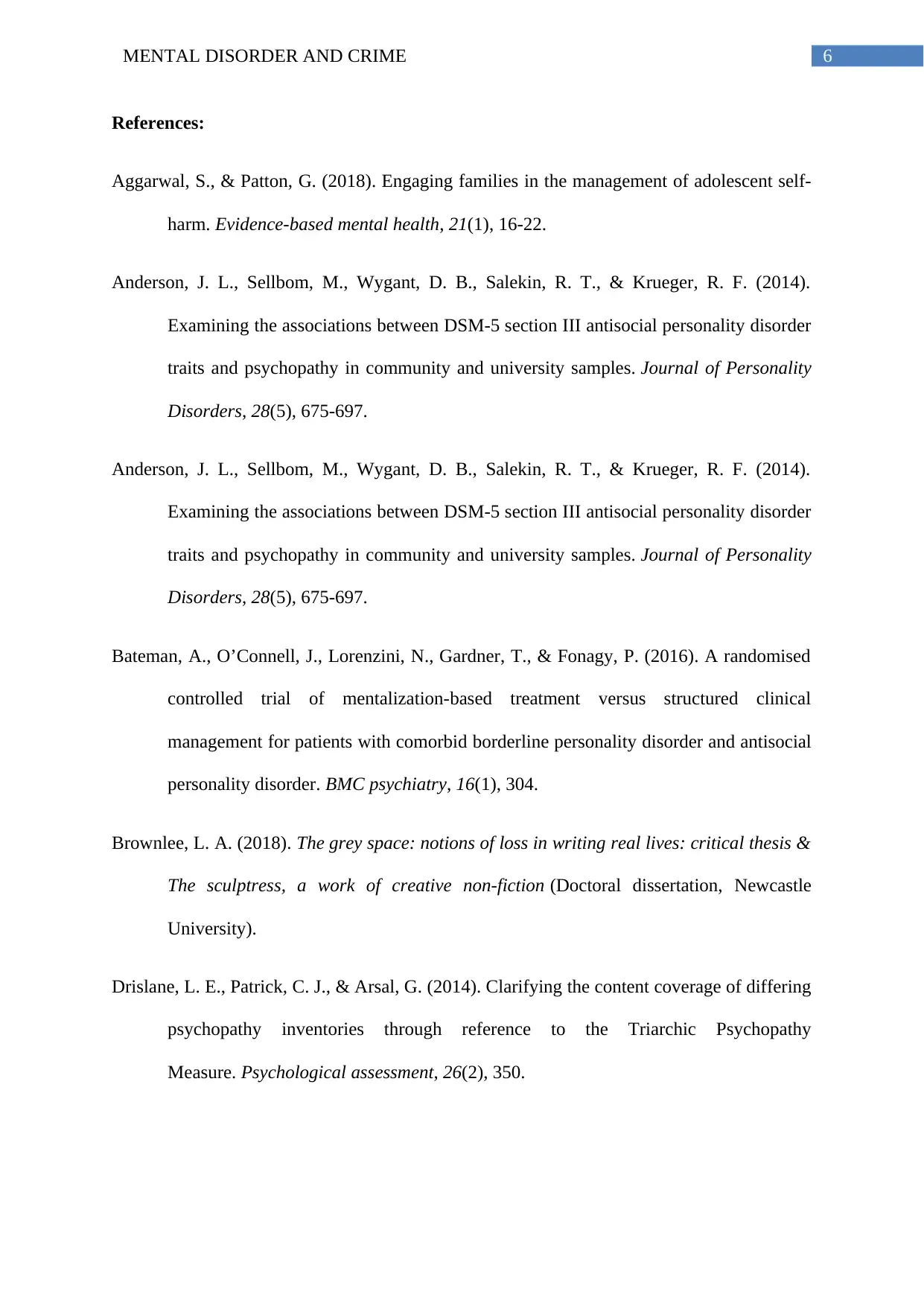
6MENTAL DISORDER AND CRIME
References:
Aggarwal, S., & Patton, G. (2018). Engaging families in the management of adolescent self-
harm. Evidence-based mental health, 21(1), 16-22.
Anderson, J. L., Sellbom, M., Wygant, D. B., Salekin, R. T., & Krueger, R. F. (2014).
Examining the associations between DSM-5 section III antisocial personality disorder
traits and psychopathy in community and university samples. Journal of Personality
Disorders, 28(5), 675-697.
Anderson, J. L., Sellbom, M., Wygant, D. B., Salekin, R. T., & Krueger, R. F. (2014).
Examining the associations between DSM-5 section III antisocial personality disorder
traits and psychopathy in community and university samples. Journal of Personality
Disorders, 28(5), 675-697.
Bateman, A., O’Connell, J., Lorenzini, N., Gardner, T., & Fonagy, P. (2016). A randomised
controlled trial of mentalization-based treatment versus structured clinical
management for patients with comorbid borderline personality disorder and antisocial
personality disorder. BMC psychiatry, 16(1), 304.
Brownlee, L. A. (2018). The grey space: notions of loss in writing real lives: critical thesis &
The sculptress, a work of creative non-fiction (Doctoral dissertation, Newcastle
University).
Drislane, L. E., Patrick, C. J., & Arsal, G. (2014). Clarifying the content coverage of differing
psychopathy inventories through reference to the Triarchic Psychopathy
Measure. Psychological assessment, 26(2), 350.
References:
Aggarwal, S., & Patton, G. (2018). Engaging families in the management of adolescent self-
harm. Evidence-based mental health, 21(1), 16-22.
Anderson, J. L., Sellbom, M., Wygant, D. B., Salekin, R. T., & Krueger, R. F. (2014).
Examining the associations between DSM-5 section III antisocial personality disorder
traits and psychopathy in community and university samples. Journal of Personality
Disorders, 28(5), 675-697.
Anderson, J. L., Sellbom, M., Wygant, D. B., Salekin, R. T., & Krueger, R. F. (2014).
Examining the associations between DSM-5 section III antisocial personality disorder
traits and psychopathy in community and university samples. Journal of Personality
Disorders, 28(5), 675-697.
Bateman, A., O’Connell, J., Lorenzini, N., Gardner, T., & Fonagy, P. (2016). A randomised
controlled trial of mentalization-based treatment versus structured clinical
management for patients with comorbid borderline personality disorder and antisocial
personality disorder. BMC psychiatry, 16(1), 304.
Brownlee, L. A. (2018). The grey space: notions of loss in writing real lives: critical thesis &
The sculptress, a work of creative non-fiction (Doctoral dissertation, Newcastle
University).
Drislane, L. E., Patrick, C. J., & Arsal, G. (2014). Clarifying the content coverage of differing
psychopathy inventories through reference to the Triarchic Psychopathy
Measure. Psychological assessment, 26(2), 350.
Paraphrase This Document
Need a fresh take? Get an instant paraphrase of this document with our AI Paraphraser
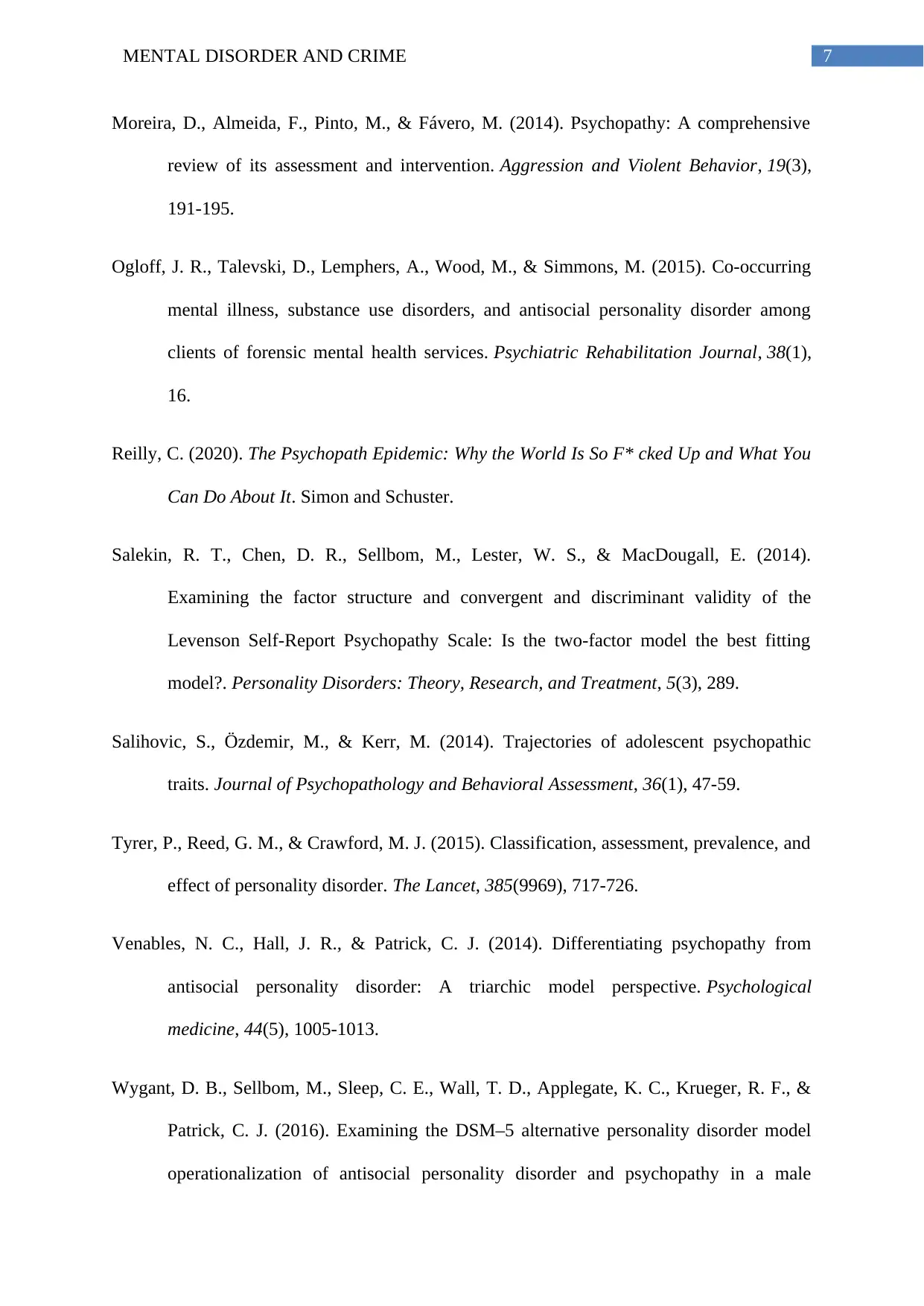
7MENTAL DISORDER AND CRIME
Moreira, D., Almeida, F., Pinto, M., & Fávero, M. (2014). Psychopathy: A comprehensive
review of its assessment and intervention. Aggression and Violent Behavior, 19(3),
191-195.
Ogloff, J. R., Talevski, D., Lemphers, A., Wood, M., & Simmons, M. (2015). Co-occurring
mental illness, substance use disorders, and antisocial personality disorder among
clients of forensic mental health services. Psychiatric Rehabilitation Journal, 38(1),
16.
Reilly, C. (2020). The Psychopath Epidemic: Why the World Is So F* cked Up and What You
Can Do About It. Simon and Schuster.
Salekin, R. T., Chen, D. R., Sellbom, M., Lester, W. S., & MacDougall, E. (2014).
Examining the factor structure and convergent and discriminant validity of the
Levenson Self-Report Psychopathy Scale: Is the two-factor model the best fitting
model?. Personality Disorders: Theory, Research, and Treatment, 5(3), 289.
Salihovic, S., Özdemir, M., & Kerr, M. (2014). Trajectories of adolescent psychopathic
traits. Journal of Psychopathology and Behavioral Assessment, 36(1), 47-59.
Tyrer, P., Reed, G. M., & Crawford, M. J. (2015). Classification, assessment, prevalence, and
effect of personality disorder. The Lancet, 385(9969), 717-726.
Venables, N. C., Hall, J. R., & Patrick, C. J. (2014). Differentiating psychopathy from
antisocial personality disorder: A triarchic model perspective. Psychological
medicine, 44(5), 1005-1013.
Wygant, D. B., Sellbom, M., Sleep, C. E., Wall, T. D., Applegate, K. C., Krueger, R. F., &
Patrick, C. J. (2016). Examining the DSM–5 alternative personality disorder model
operationalization of antisocial personality disorder and psychopathy in a male
Moreira, D., Almeida, F., Pinto, M., & Fávero, M. (2014). Psychopathy: A comprehensive
review of its assessment and intervention. Aggression and Violent Behavior, 19(3),
191-195.
Ogloff, J. R., Talevski, D., Lemphers, A., Wood, M., & Simmons, M. (2015). Co-occurring
mental illness, substance use disorders, and antisocial personality disorder among
clients of forensic mental health services. Psychiatric Rehabilitation Journal, 38(1),
16.
Reilly, C. (2020). The Psychopath Epidemic: Why the World Is So F* cked Up and What You
Can Do About It. Simon and Schuster.
Salekin, R. T., Chen, D. R., Sellbom, M., Lester, W. S., & MacDougall, E. (2014).
Examining the factor structure and convergent and discriminant validity of the
Levenson Self-Report Psychopathy Scale: Is the two-factor model the best fitting
model?. Personality Disorders: Theory, Research, and Treatment, 5(3), 289.
Salihovic, S., Özdemir, M., & Kerr, M. (2014). Trajectories of adolescent psychopathic
traits. Journal of Psychopathology and Behavioral Assessment, 36(1), 47-59.
Tyrer, P., Reed, G. M., & Crawford, M. J. (2015). Classification, assessment, prevalence, and
effect of personality disorder. The Lancet, 385(9969), 717-726.
Venables, N. C., Hall, J. R., & Patrick, C. J. (2014). Differentiating psychopathy from
antisocial personality disorder: A triarchic model perspective. Psychological
medicine, 44(5), 1005-1013.
Wygant, D. B., Sellbom, M., Sleep, C. E., Wall, T. D., Applegate, K. C., Krueger, R. F., &
Patrick, C. J. (2016). Examining the DSM–5 alternative personality disorder model
operationalization of antisocial personality disorder and psychopathy in a male

8MENTAL DISORDER AND CRIME
correctional sample. Personality Disorders: Theory, Research, and Treatment, 7(3),
229.
correctional sample. Personality Disorders: Theory, Research, and Treatment, 7(3),
229.
1 out of 9
Related Documents
Your All-in-One AI-Powered Toolkit for Academic Success.
+13062052269
info@desklib.com
Available 24*7 on WhatsApp / Email
![[object Object]](/_next/static/media/star-bottom.7253800d.svg)
Unlock your academic potential
© 2024 | Zucol Services PVT LTD | All rights reserved.





